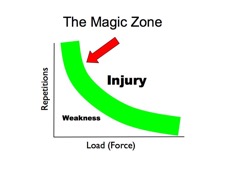Osteoarthritis – Cartilage and Exercise

Osteoarthritis is primarily a degeneration, or wear and tear, of the hyaline cartilage that covers the end of the joint surfaces. Osteoarthritis occurs as a result of “the parents you choose” (genetic influence) or as a sequel to a prior joint trauma or injury. There is a great deal of information dealing with the process of repair or healing of cartilage, but there is less information about how mechanical stress and exercise facilitates or adversely affects cartilage repair or healing.
A global theoretical framework is that all types of tissues respond to physical stress, by either a decreased stress tolerance, maintenance of stress tolerance or increased stress tolerance. If the stress/load is too high, injury occurs. If there is not enough stress/load, the tissue degenerates. If there is an appropriate amount of stress/load, the tissue adapts and grows. These same principals apply to injured tissue, an appropriate amount of exercise stress is therapeutic and stress/load that is too little or too much is harmful.
Mechanical stresses and exercise do have an effect on cartilage tissue repair, but cartilage seems to differ from other musculoskeletal tissues. Cartilage does not increase tissue mass after reaching adulthood whereas muscles, tendons and ligaments become larger in response to exercise.
There is strong evidence that therapeutic exercises provide pain relief and improve function for individuals with osteoarthritis of the knees. There is lack of agreement as to which is the most effective type of exercise or amount/degree of exercise. The evidence does not clarify the mechanism by which pain is decreased and function is improved. One theory is that exercise improves the strength of surrounding muscle tissue which helps dissipate the stress on the cartilage. Another theory is that mechanical stress and exercise directly stimulates development and repair of the cartilage resulting in decreased pain and improved function.
The challenge then is to determine what the appropriate stress/load (exercise) to facilitate healing or to simulate cartilage growth/repair should be. This challenge is complicated by the fact that cartilage tissue has no blood vessels, blood or nerves. Therefore, the typical signs of pain and swelling telling us that stress/load has reached the injury threshold, may not occur. Or if pain and swelling do occur, we tend to ignore these subtle signs. Most tissues typically receive nutrition from blood. Hyaline cartilage found in the knees is bloodless; it receives nutrition from the synovial fluid (joint lubricant) that is normally in the joint. This fluid is moved into and out of the hyaline cartilage by movement of the joint that changes the pressures inside the joint, forcing the nutrients into the hyaline cartilage.
Doug Kelsey a Physical Therapist, has proposed an interesting theory to determine optimal level of stress/load (exercise) to facilitate appropriate cartilage tissue adaptation or healing, that involves adjusting the stress/load and the number of repetitions. He proposed that there is an optimal amount of load and repetitions that result in cartilage adaptation which he calls the magic zone. If the load or repetitions exceeds a safe threshold, injury occurs. The major determinant of load is an individual’s body weight. Theoretically, if the load is decreased below the magic zone, deterioration of the cartilage occurs. This would happen is the individual became a couch potato.

If the repetitions of movements increased beyond the safe threshold, injury occurs. For some individuals, repeating the foot striking the ground enough times to complete a 5 to 10 Kilometer race, results in reaching the Magic Zone. But repeating the foot strike the number of times it takes to complete a ½ marathon, may result in going over the threshold and injuring or damaging the cartilage.
Increase the number of repetitions
Given the relationship between load/stress and number of repetitions, a simple approach is to decrease the load and/or increase the number of repetitions. As long as the load is in the magic zone, the more repetitions the joint goes through, the more opportunity there is to move and push the nutritious joint fluid into the hyaline cartilage. The more repetitions a joint moves through a large range of motion, the better, as each nook and cranny of joint surfaces are subjected to beneficial pressures. Increasing the number of repetitions has beneficial effects in terms of improving cardiovascular and muscular systems and in controlling or decreasing body weight.
Strategies to decrease load
There are a variety of ways to decrease load: traveling to zero gravity (outer space); exercising in water; loosing body weight; specialized “unloading exercise equipment” such as a Total Gym ® or Newton Trainer ®; partial weight bearing exercise equipment (stationary bike, rowers, elliptical machines, stair masters); “unloading knee” braces and assistive devices such as canes, walkers, carts or walking sticks. Certain techniques of walking/running can decrease load: avoiding heel strike; shortening stride length and limiting up and down motion.
Time:
A unique feature of cartilage is how slow healing occurs. Muscles heal the fastest, tendons take longer and cartilage takes much longer than tendons to heal. Generally muscle and tendon heal to 80% of their original strength in 6 to 8 weeks time. Estimates dealing with cartilage healing to achieve 80% of their original strength vary from 12 weeks to 9 months. Bottom line – injury to a cartilage takes a frustratingly long time to heal. For osteoarthritis of the knee, the recommendation is to identify a strategy to decrease the load and increase the repetitions, but to pay close attention to the very subtle signs of exceeding the magic threshold and have a great deal of patience.
Damien Howell Physical Therapy – 804-647-9499 – Fax: 866-879-8591 At-Home, At Office, At Fitness Facility – I come to you, I do home visits Damien@damienhowellpt.com
